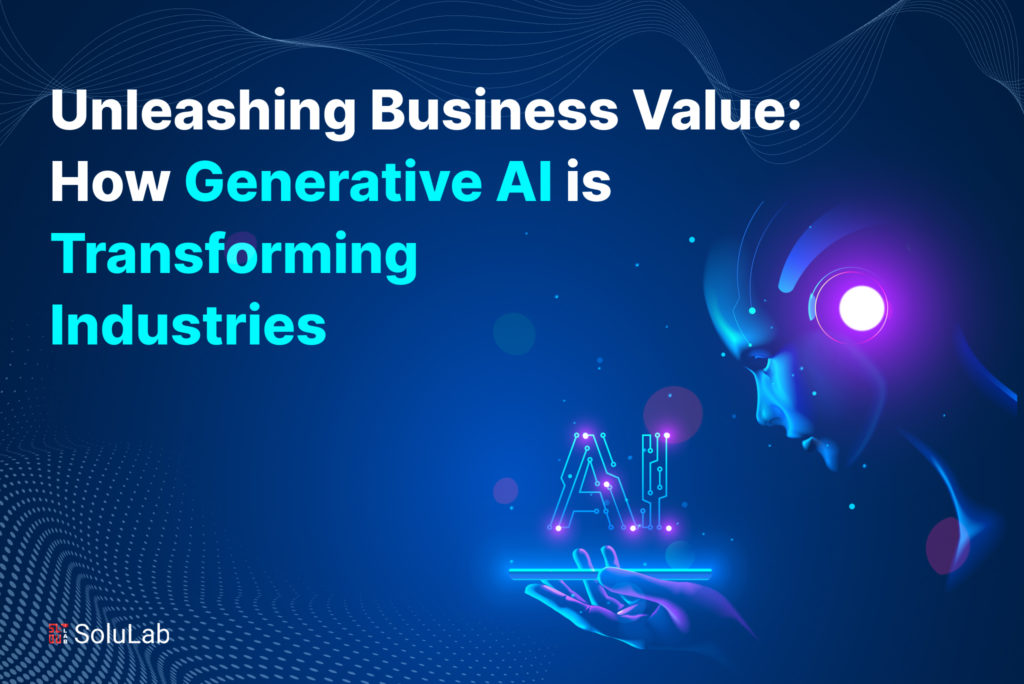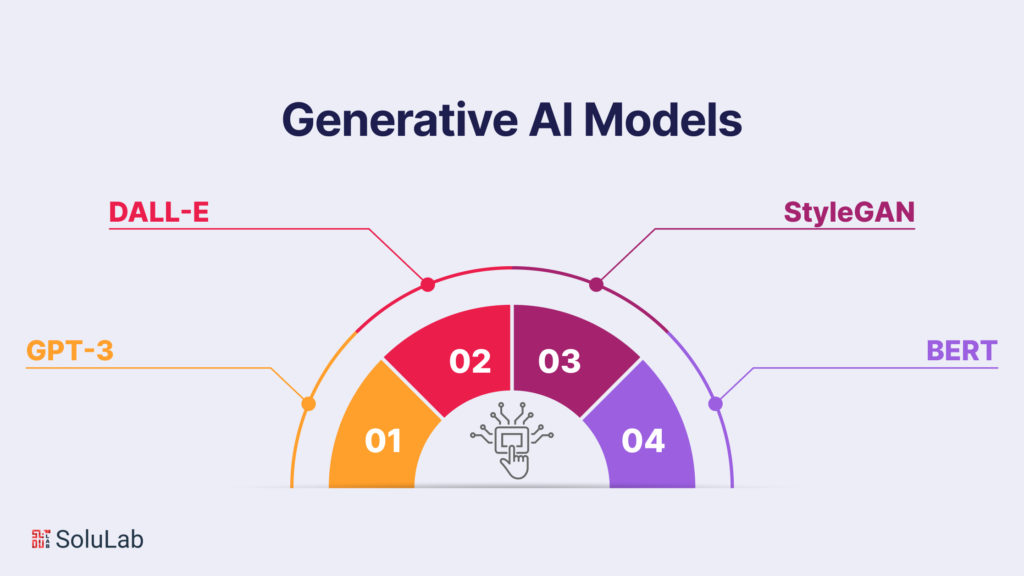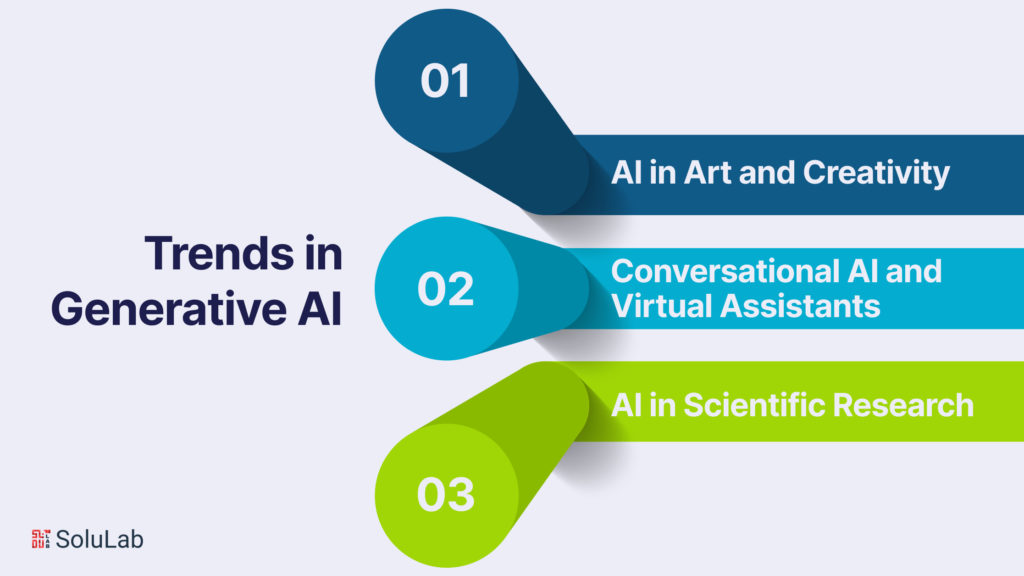
In the ever-evolving landscape of technology, artificial intelligence (AI) has been a driving force behind transformative changes in various industries. Within the realm of AI, Generative AI has emerged as a powerful tool with the potential to reshape entire sectors, disrupt traditional business models, and unlock unprecedented value. In this comprehensive blog, we will delve deep into the world of Generative AI, exploring its technology, applications, and profound impact on diverse industries.
Understanding Generative AI
Generative AI, a subset of Artificial Intelligence (AI), is a fascinating technology that focuses on the creation of content rather than traditional problem-solving or decision-making tasks. Here are a few things to know about Generative AI.
Generative AI, short for Generative Artificial Intelligence, is a subset of artificial intelligence that focuses on enabling machines to generate content, data, or even human-like responses. What sets Generative AI apart is its ability to produce original content rather than relying solely on pre-existing data or patterns. It leverages neural networks, particularly generative models, to create content that can be remarkably human-like in quality.
At its core, Generative AI is all about teaching machines to be creative, innovative, and capable of independent thought, albeit within the parameters and data it’s trained on. It’s a significant departure from traditional AI, which primarily involves pattern recognition and data analysis.
How Generative AI Differs from Other AI Models?
To understand Generative AI better, it’s crucial to differentiate it from other AI models. In traditional AI, models are designed for specific tasks, such as image recognition or language translation. These models excel in their predefined roles but lack the versatility of Generative AI.
Generative AI models, on the other hand, are designed to be creative and adaptable. They can generate text, images, music, and more, making them incredibly versatile. They don’t rely solely on structured data; instead, they learn from vast datasets and then create content that fits within the patterns they’ve learned. This flexibility has made Generative AI a game-changer in various industries.
The Inner Workings of Generative AI Technology
Generative AI’s inner workings are a blend of mathematics, computer science, and neural networks. At its core, it relies on deep learning techniques, specifically generative models. These models are trained on extensive datasets, learning patterns, and correlations within the data.
Generative models use various algorithms and architectures, such as Variational Autoencoders (VAEs), Generative Adversarial Networks (GANs), and Transformers, to create content. VAEs and GANs are well-known for their ability to generate images and other multimedia content, while Transformers excel in natural language processing tasks, such as text generation and translation.
Generative AI Models: A Closer Look

Generative AI is a vast field with numerous models, each designed for specific tasks. Some of the most prominent Generative AI models include:
- GPT-3 (Generative Pre-trained Transformer 3): Developed by OpenAI, GPT-3 is a language-based model capable of generating human-like text. It has gained immense attention for its natural language understanding and generation capabilities.
- DALL-E: Also from OpenAI, DALL-E generates images from text descriptions. It’s known for creating unique and imaginative visual content based on textual prompts.
- StyleGAN: This model, developed by NVIDIA, is used for generating realistic images, especially faces. It can create high-resolution images of people who don’t even exist.
- BERT (Bidirectional Encoder Representations from Transformers): Although primarily used for language understanding tasks, BERT has generative capabilities and can be fine-tuned for text generation tasks.
Use Cases of Generative AI

Generative AI, which includes models like GPT-3 and its successors, has a wide range of use cases across various industries. These models have the ability to generate human-like text, images, and even music. Here are some notable use cases of generative AI:
-
Natural Language Processing (NLP)
Generative AI technology has achieved remarkable success in natural language processing tasks. One of the key models driving this progress is GPT-3 (Generative Pre-trained Transformer 3). GPT-3 can generate coherent and contextually relevant text, making it a game-changer for various applications. Content generation is a prominent use case. GPT-3 can generate articles, marketing copy, and even code snippets. This has implications for content creators, businesses, and developers looking to streamline their workflows. Another application is chatbots and virtual assistants. GPT-3 can power chatbots that provide more human-like interactions, enhancing customer support and engagement. OpenAI’s ChatGPT is a prime example of this technology in action.
-
Image Generation and Manipulation
Generative AI models like StyleGAN and DALL-E have reshaped the creative landscape when it comes to images. StyleGAN, for instance, can create photorealistic faces of people who don’t exist. This has implications for the entertainment industry, where CGI characters can be generated with ease. DALL-E, on the other hand, takes textual descriptions and generates corresponding images. This is a boon for designers and artists looking to bring their ideas to life visually. Advertisers can also benefit from this technology by generating visuals for their campaigns.
-
Drug Discovery and Healthcare
In the field of drug discovery, Generative AI has made significant strides. It can predict molecular structures and assess their potential as drugs. This accelerates the drug development process, reducing costs and timeframes. Generative AI is also vital in medical image analysis. It can assist radiologists in identifying anomalies in X-rays, MRIs, and CT scans. This not only enhances diagnostic accuracy but also speeds up the process, which is crucial in healthcare.
-
Content Recommendation and Personalization
Generative AI plays a crucial role in content recommendation systems. It can analyze user behavior and preferences to generate personalized recommendations. Streaming platforms like Netflix and music services like Spotify rely on these algorithms to keep users engaged. Moreover, e-commerce platforms use Generative AI to suggest products based on user browsing and purchase history. This leads to increased sales and customer satisfaction. As AI continues to improve its understanding of user preferences, these recommendations will become even more accurate and effective.
-
Creative Content Generation
Generative AI has transformed the way creative content is produced. Whether it’s generating text, images, music, or videos, Generative AI can assist or even take the lead in content creation. This has implications for content creators, marketers, and artists, who can now harness AI’s creative power to streamline their workflows and push the boundaries of their craft.
-
Data Augmentation and Enhancement
In data-driven fields like machine learning and research, Generative AI plays a vital role in data augmentation. By generating synthetic data that mimics real-world data, it helps improve the robustness and performance of AI models. Additionally, Generative AI can enhance low-quality images or videos, making them more usable and visually appealing.
-
Personalization and Customer Engagement
Generative AI has revolutionized personalization in customer experiences. Chatbots and virtual assistants powered by Generative AI technology can engage customers with human-like interactions, answering queries and providing personalized recommendations. This not only enhances customer satisfaction but also streamlines customer support.
-
Scientific Discovery and Research
Generative AI is a game-changer in scientific research. It can analyze complex datasets, identify patterns, and generate hypotheses that would be challenging for humans to discern. In genomics, AI-driven analysis of DNA sequences is helping uncover genetic patterns related to diseases and traits. Similarly, in materials science, AI models are aiding in the discovery of new materials with unique properties, potentially revolutionizing various industries.
-
Healthcare and Medical Advancements
The healthcare industry benefits immensely from Generative AI. It can assist radiologists in identifying anomalies in medical images like X-rays, MRIs, and CT scans, enhancing diagnostic accuracy and speed. In drug discovery, Generative AI models simulate molecular structures, significantly accelerating the process. This has the potential to revolutionize the pharmaceutical industry by reducing drug development timelines and costs.
Related: Generative AI in Healthcare
-
Manufacturing and Supply Chain Optimization
Manufacturing and Industry 4.0 are transformed by Generative AI. It plays a significant role in predictive maintenance, where AI models predict when machines or equipment are likely to fail, allowing for timely maintenance and reducing downtime. Supply chain optimization benefits from AI’s ability to forecast demand, optimize inventory levels, and streamline logistics, resulting in cost savings and operational efficiency.
Generative AI Transforming the Industries

Generative AI has the potential to transform various industries by automating tasks, enhancing creativity, and improving decision-making processes. Here’s a look at how generative AI can impact different sectors:
-
Revolutionizing Healthcare
Generative AI industries are ushering in a revolution in healthcare. Its ability to analyze vast amounts of medical data and generate insights is invaluable. For instance, Generative AI can help in medical image analysis, assisting radiologists in detecting anomalies in X-rays or MRIs with high accuracy. Moreover, it can be used to predict disease outbreaks by analyzing global health data and recognizing patterns that humans might overlook. In drug discovery, Generative AI models can simulate molecular structures, significantly accelerating the process. Traditional drug discovery often takes years, but with the aid of AI-generated compounds, this timeline can be drastically reduced. Companies like Insilico Medicine are at the forefront of using Generative AI for drug development.
-
Transforming Creative Industries
The creative landscape is experiencing a paradigm shift thanks to Generative AI. One of the most notable examples is the art generation. Generative models like DALL-E can take textual descriptions and turn them into stunning and imaginative visual art. This has opened up new avenues for artists and designers, allowing them to explore ideas that were previously unattainable. Music composition is another area being transformed. AI can analyze existing music and create original compositions in various styles. This is not about replacing musicians but rather collaborating with AI to enhance creativity. Projects like AIVA are producing beautiful symphonies, demonstrating how Generative AI can be a muse for human artists.
-
Redefining Finance and Investment
The financial sector is no stranger to data-driven decision-making, and Generative AI is taking it to the next level. In trading, AI models can analyze vast datasets in real-time, identifying trading patterns and making split-second decisions. Hedge funds and asset management firms are increasingly relying on AI-powered trading algorithms to gain an edge in the market. Risk assessment is another critical area. Banks and insurance companies use Generative AI industries to predict creditworthiness and assess insurance claims. This not only speeds up processes but also enhances accuracy. It’s a win-win for businesses and customers.
-
Enhancing Customer Experiences
Generative AI is redefining customer experiences across industries. Chatbots and virtual assistants powered by Generative AI can provide more human-like interactions, solving customer queries and offering personalized recommendations. This not only improves customer satisfaction but also reduces the workload of customer support teams. In e-commerce, Generative AI models can generate product descriptions, reviews, and even personalized shopping suggestions. This enhances the overall shopping experience, leading to increased sales and customer loyalty. Retail giants like Amazon are already using AI to improve product recommendations.
Trends in Generative AI

Generative AI is a rapidly evolving field, and several trends have emerged in 2023. These Generative AI trends continue to shape the development and applications of generative AI:
-
AI in Art and Creativity
The intersection of AI and creativity is a hotbed of innovation. Artists and designers are increasingly collaborating with Generative AI to push the boundaries of what’s possible. AI-generated art exhibitions are gaining popularity, blurring the lines between human and machine creativity. In music, AI-generated compositions are becoming more intricate and emotionally resonant. AI-generated literature and poetry are also emerging as fascinating experiments in generative AI & human-AI collaboration. The future of creative expression may well be a fusion of human ingenuity and AI assistance.
-
Conversational AI and Virtual Assistants
Conversational AI powered by Generative AI models is making waves in customer service and virtual assistants. These AI systems are becoming more conversational and context-aware, making interactions with AI-driven chatbots and virtual assistants feel increasingly human. Voice assistants like Siri, Alexa, and Google Assistant are also benefiting from Generative AI. They can generate natural-sounding responses and hold more dynamic and context-aware conversations. As AI becomes more integrated into our daily lives, conversational AI will continue to evolve.
-
AI in Scientific Research
Generative AI is transforming scientific research by accelerating data analysis and hypothesis generation. Researchers can use AI models to analyze complex datasets, identify patterns, and generate hypotheses that would be challenging for humans to discern. In fields like genomics, AI-driven analysis of DNA sequences is helping scientists uncover genetic patterns related to diseases and traits. Similarly, in materials science, AI models are aiding in the discovery of new materials with unique properties. These applications have the potential to revolutionize scientific discovery and innovation.
Tools and Frameworks of Generative AI

Generative AI relies on various tools and frameworks to develop, train, and deploy models for generating text, images, and other types of content. Here are some of the notable tools and frameworks commonly used in the field of generative AI:
-
OpenAI’s GPT-3 and ChatGPT
OpenAI’s GPT-3 is one of the most prominent Generative AI models available. It’s capable of a wide range of natural language processing tasks, making it a versatile tool for content generation, chatbots, and more. Developers can access GPT-3 through OpenAI’s API, allowing them to integrate it into their applications. ChatGPT, a sibling model to GPT-3, is specifically designed for chatbot applications. It powers human-like conversations and can be customized for various use cases. Developers can fine-tune ChatGPT to create chatbots that suit specific industries and customer needs.
-
StyleGAN and DALL-E by NVIDIA
NVIDIA’s StyleGAN and DALL-E have revolutionized image generation and manipulation. StyleGAN, known for its ability to create realistic faces, is available as an open-source tool. It’s widely used by artists, designers, and developers to generate high-quality images. DALL-E, another creation from NVIDIA, is currently in research and development. It has the potential to be a groundbreaking tool for generating images from textual descriptions. As these tools evolve, they are likely to become even more accessible to creative professionals.
-
AI Frameworks and Libraries
Various AI frameworks and libraries empower developers to work with Generative AI. TensorFlow and PyTorch are two popular frameworks that offer tools and resources for building and training AI models, including generative models. These frameworks come with pre-built models and tutorials to kickstart projects. Additionally, specialized libraries like Hugging Face Transformers provide pre-trained models for natural language processing tasks. These libraries simplify the process of incorporating Generative AI into applications, making it more accessible to developers.
Future Prospects of Generative AI

The future prospects of generative AI are promising and are expected to bring about significant advancements and transformations across various domains. Here are some of the key future prospects and trends for generative AI:
-
Advancements in Generative AI Models
The future of Generative AI promises even more advanced models that can create content of unprecedented quality. Researchers are working on refining existing models like GPT-3 and developing new architectures that can generate highly realistic text, images, and multimedia content.
-
Human-AI Collaboration
Generative AI will increasingly be seen as a creative tool, facilitating collaboration between humans and machines in various creative fields. Musicians, writers, artists, and designers will incorporate AI into their creative processes, pushing the boundaries of what’s possible.
-
AI-Powered Personalization
Generative AI technology will continue to enhance personalization in various industries, from entertainment to e-commerce. AI will better understand individual preferences and deliver highly tailored content, products, and experiences. This will lead to higher customer satisfaction and engagement.
Conclusion
In conclusion, Generative AI has emerged as a transformative force across industries, revolutionizing content creation, data augmentation, personalization, and more. Its ability to generate creative and contextually relevant content is reshaping how businesses operate and innovate. As we’ve explored, Generative AI is not only a technological breakthrough but also a catalyst for efficiency, creativity, and innovation.
In this rapidly evolving landscape, staying ahead in Generative AI development is crucial. Businesses seeking to harness the full potential of Generative AI can benefit from Generative AI development services and solutions. These services encompass a spectrum of offerings, from custom Generative AI model development to consulting services that guide organizations in integrating Generative AI into their workflows.
When it comes to Generative AI development services, SoluLab stands out as a leading partner. With a team of top Generative AI developers and experts, SoluLab offers comprehensive Generative AI development solutions tailored to your specific needs. Whether you aim to automate content generation, enhance data quality, or innovate in your industry, SoluLab’s Generative AI consulting services can help you achieve your goals. By partnering with SoluLab and leveraging their expertise in Generative AI development, businesses can unlock new possibilities, streamline operations, and pioneer innovation in their respective domains. As Generative AI continues to evolve, SoluLab remains at the forefront, empowering businesses to thrive in a generative AI-powered future.
FAQs
1. What is Generative AI, and how does it differ from other AI models?
Generative AI is a subset of artificial intelligence that focuses on creating data, content, or solutions autonomously. Unlike other AI models that primarily analyze and interpret existing data, Generative AI has the unique ability to generate new and original content, making it a powerful tool for creative tasks, data augmentation, and personalization.
2. What are some prominent use cases of Generative AI technology?
Generative AI technology finds application in various industries, including content generation, data augmentation, personalized recommendations, scientific research, healthcare, finance, manufacturing, and more. Specific use cases include generating creative content, enhancing data quality, optimizing supply chains, and predicting financial trends.
3. How is Generative AI transforming industries?
Generative AI is driving significant transformations across industries by automating tasks, improving efficiency, and fostering innovation. In entertainment, it’s revolutionizing content creation; in healthcare, it’s accelerating drug discovery; and in finance, it’s enhancing risk management and forecasting.
4. What are the key trends in the Generative AI landscape?
Some key trends in the Generative AI landscape include the rapid evolution of Generative AI models, ethical considerations related to AI-generated content, privacy and security concerns, and the development of regulatory frameworks. Additionally, collaborative AI, where humans work alongside Generative AI systems, is gaining prominence.
5. How can businesses benefit from Generative AI development services?
Businesses can benefit from Generative AI development services by leveraging the expertise of top Generative AI developers to build custom AI models tailored to their needs. These services enable organizations to automate processes, enhance content quality, and innovate in their industries.
6. What sets SoluLab apart in the field of Generative AI development?
SoluLab distinguishes itself in Generative AI development by offering comprehensive solutions and consulting services. With a team of top Generative AI developers, SoluLab provides customized Generative AI development services, empowering businesses to harness the power of AI for content generation, data enhancement, and innovation.
7. How can I hire top Generative AI developers for my project?
To hire top Generative AI developers, you can reach out to experienced AI development firms like SoluLab. They have a pool of skilled professionals with expertise in Generative AI technology. By partnering with such firms, you gain access to top talent to bring your AI projects to life.






